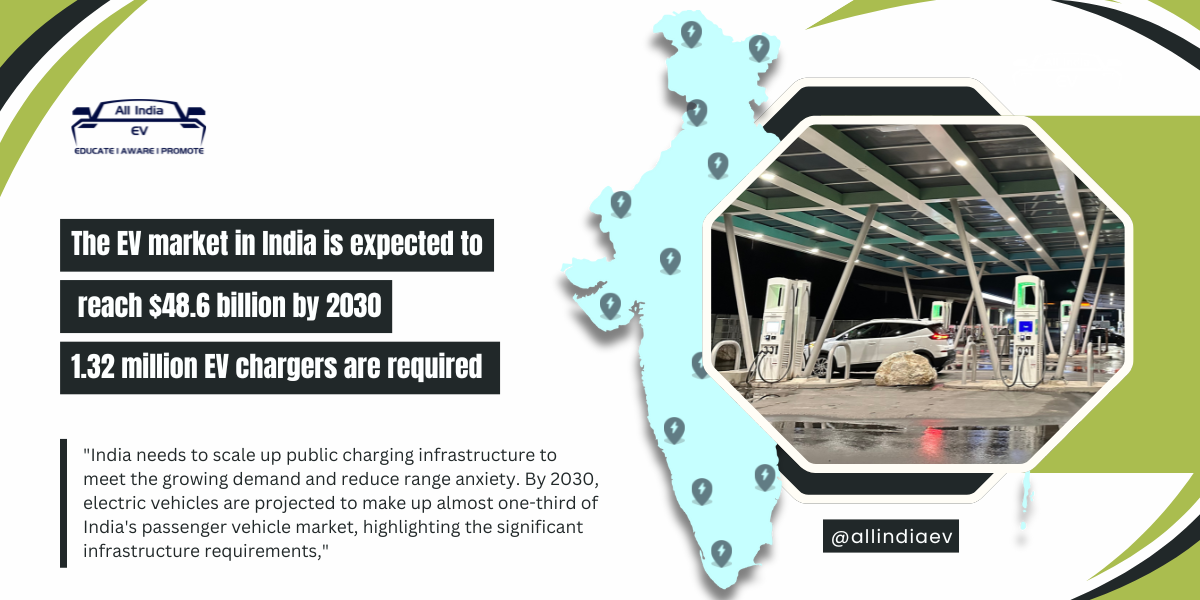
India’s EV uplift needs 1.32 million chargers by 2030.
A roaring electric vehicle revolution could be standing at India’s doorstep, with forecasts suggesting that almost a third of all passenger vehicles running on the road may be electric by 2030. This transformation can bring both clean air and freedom from dependence on fossil fuels. The realization of this laudable aspiration rests on a very critical component: strong infrastructure for chargers.
For India to alleviate range anxiety and quicken EV adoption, it will need to dramatically grow the public charging network. Demand for easily accessible, convenient charging points will surge along with the number of cars running into millions. This is matched by an equivalent improvement in the charging ecosystem. It could retard the growth of the EV market and, hence, the transition to sustainable mobility in the country.

India’s EV Charge: A Rapidly Expanding Network
India’s electric vehicle landscape is moving through a sea of change, where the market will surge to an astounding $48.6 billion by 2030 alone, says a report by Forvis Mazars. The charting of this growth trajectory is inextricably related to the rapid proliferation of public battery-electric vehicle (BEV) charging stations.
From a mere 1,800 public charging stations in February 2022 to almost nine times that number—16,347—in March 2024, the growth comes out to be strategically steep. It therefore indicates that India is at the forefront of supporting the fast-growing EV ecosystem. This strategic expansion marks the commitment of a country toward meeting surging demand for electric vehicles and ensuring a sustainable transport future.
Partner and Transport and Logistics Sector Leader at Forvis Mazars in India, Rohit Chaturvedi, made it urgent to scale up infrastructure. He said, “India needs to scale up public charging infrastructure to meet the growing demand and reduce range anxiety. By 2030, electric vehicles are projected to make up almost one-third of India’s passenger vehicle market, highlighting the significant requirements.“
India’s Electric Future: Charging Towards a Million
India hovers on the brink of exponential growth in EVs, with 50 million EVs on the road by 2030 with a market valuation of $48.6 billion. To support such charging of vehicles, there would need to be over 400,000 charging stations created each year until it is fully developed. Which would reach a total of 1.32 million charging points by 2030. The Ministry of Heavy Industries has also taken a keen interest in sanctioning 2,877 EV chargers. Across different states and another 1,576 along the main highways and expressways.
Electric vehicle markets are booming around the world. Electric vehicle global sales rose 27% from 2022 to 2023 to a record 13.06 million. The sharp growth in electric vehicles requires, as a matter of urgency, a scaling-up of the charging infrastructure supporting this huge ecosystem. Factually, there are 40 million electric vehicles globally as of 2024, whereas this makes the charging setup even more inevitable in this journey of migration towards electric mobility.
India’s Electric Revolution: A Three-Wheeled Surge
India’s EV landscape is rapidly changing. EV sales more than tripled in the past fiscal year, driven primarily by enhanced demand for electric two-wheelers and three-wheelers. This rapid acceleration is a testament to the growing preference for eco-friendly and cost-effective transportation solutions.
The four-wheeler segment will see tremendous growth, with a pipeline of new models lined up for launch. The EV revolution is here, and it is driven by several factors. Lower operational costs, easy user experiences, and commitments to sustainability are fast becoming the drivers of consumer choice. This is supplemented by not only a fast-growing supplier ecosystem but also opportunities in vehicle customization for EV owners. Initiatives of state governments, coupled with the FAME-II subsidy scheme, have also played a major role in accelerating EV adoption.




